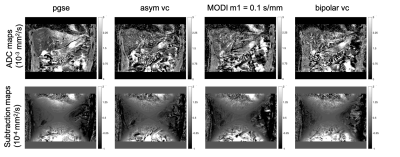Sean McTavish1, Anh T. Van1, Johannes M. Peeters2, Kilian Weiss3, Marcus R. Makowski1, Rickmer F. Braren1, and Dimitrios C. Karampinos1
1Department of Diagnostic and Interventional Radiology, Technical University of Munich, Munich, Germany, 2Philips Healthcare, Best, Netherlands, 3Philips Healthcare, Hamburg, Germany
1Department of Diagnostic and Interventional Radiology, Technical University of Munich, Munich, Germany, 2Philips Healthcare, Best, Netherlands, 3Philips Healthcare, Hamburg, Germany
Gradient non-linearity correction can remove bias in ADC quantification when using motion compensated waveforms and there is a synergistic effect between the motion-induced signal loss and the gradient non-linearity correction in the left liver lobe.

Figure 5: The ADC maps for the motion compensated waveforms do not show as large of an ADC overestimation in the left liver lobe when compared with pgse. The subtraction maps therefore do not show as large of a difference between the gnl corrected and non-corrected ADC maps.

Figure 3: Phantom results for all waveforms. The non-corrected ADC for an ROI drawn in the centre of the phantom shows the characteristic gradient nonlinearity induced parabolic shape. After correction, this bias is reduced for all waveforms, even if the variation in the ADC of the motion compensated waveforms is larger than pgse.